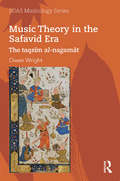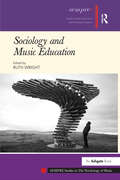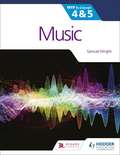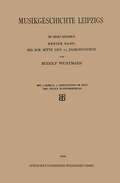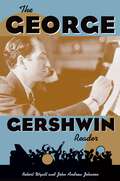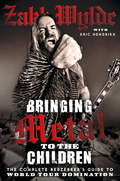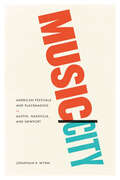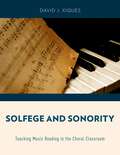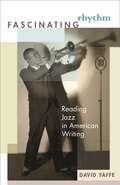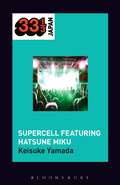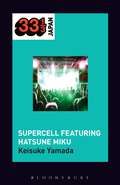- Table View
- List View
Music Theory in Mamluk Cairo: The ġāyat al-maṭlūb fī ‘ilm al-adwār wa-’l-ḍurūb by Ibn Kurr (SOAS Studies in Music)
by Owen WrightThe ġāyat al-maṭlūb fī ‘ilm al-adwār wa-'l-ḍurūb by Ibn Kurr is the only theoretical text of any substance that can be considered representative of musicological discourse in Cairo during the first half of the fourteenth century CE. Indeed, nothing comparable survives from the whole Mamluk period, which extends from 1260 until the Ottoman invasion and conquest of Egypt in 1516. But its value does not derive merely from its fortuitous isolation: it is important, rather, because of the richness of the information it provides with regard to modal and rhythmic structures, and also because of the extent to which the definitions it offers differ from those set forth in an interrelated series of major theoretical works in both Arabic and Persian that span the period from the middle of the thirteenth century to the late fifteenth. Alongside the presumption of transregional uniformity these texts suggest, it consequently asserts the significance of local particularism. Owen Wright provides a critical edition of the text itself, together with a glossary, prefaced by an introduction and a detailed commentary and analysis. The introduction provides immediate context, situating the work in relation to the dominant theoretical tradition of the period and providing biographical information about the author, active in Cairo during the first half of the fourteenth century.
Music Theory in the Safavid Era: The taqsīm al-naġamāt (SOAS Studies in Music Series)
by Owen WrightThe Safavid era (1501–1722) is one of the most important in the history of Persian culture, celebrated especially for its architecture and art, including miniature paintings that frequently represent singers and instrumentalists. Their presence reflects a sophisticated tradition of music making that was an integral part of court life, yet it is one that remains little known, for the musicological literature of the period is rather thin. There is, however, a significant exception: the text presented and analysed here, a hitherto unpublished and anonymous theoretical work probably of the middle of the sixteenth century. With a Sufi background inspiring the use of the nay as a tool of theoretical demonstration, it is exceptional in presenting descriptive accounts of the modes then in use and suggesting how these might be arranged in complex sequences. As it also gives an account of the corpus of rhythmic cycles it provides a unique insight into the basic structures of art-music during the first century of Safavid rule.
Touraj Kiaras and Persian Classical Music: An Analytical Perspective
by Owen WrightIn this book Owen Wright analyses a single recording of classical Persian music made by Touraj Kiaras, a distinguished singer, accompanied by four noted instrumentalists. The format of the recording is typical of a public concert performance, and thus includes instrumental compositions as well as a central exploration of vocal repertoire and technique. The analysis identifies salient structural features, whether of the individual components or of the whole, in a way accessible to the western reader, but it also takes account of the analytical metalanguage used in Persian scholarship, and includes consideration of the relationship between music and poetry. It is important to note that it is also guided by the perceptions of the performer, whose input and responses to questions have significantly influenced the enterprise. To avoid the dryly impersonal, the analysis is also framed by an introduction which combines a biographical sketch of Touraj Kiaras with a survey of the twentieth-century evolution of Persian classical music and of the position of the vocal repertoire within it, and by an epilogue which examines further the ideological basis of prevalent attitudes to music, and seeks to explore the validity of the analytical enterprise within this context.
Touraj Kiaras and Persian Classical Music: An Analytical Perspective
by Owen WrightIn this book Owen Wright analyses a single recording of classical Persian music made by Touraj Kiaras, a distinguished singer, accompanied by four noted instrumentalists. The format of the recording is typical of a public concert performance, and thus includes instrumental compositions as well as a central exploration of vocal repertoire and technique. The analysis identifies salient structural features, whether of the individual components or of the whole, in a way accessible to the western reader, but it also takes account of the analytical metalanguage used in Persian scholarship, and includes consideration of the relationship between music and poetry. It is important to note that it is also guided by the perceptions of the performer, whose input and responses to questions have significantly influenced the enterprise. To avoid the dryly impersonal, the analysis is also framed by an introduction which combines a biographical sketch of Touraj Kiaras with a survey of the twentieth-century evolution of Persian classical music and of the position of the vocal repertoire within it, and by an epilogue which examines further the ideological basis of prevalent attitudes to music, and seeks to explore the validity of the analytical enterprise within this context.
Sociology and Music Education
by Ruth WrightSociology and Music Education addresses a pressing need to provide a sociological foundation for understanding music education. The music education community, academic and professional, has become increasingly aware of the need to locate the issues facing music educators within a broader sociological context. This is required both as a means to deeper understanding of the issues themselves and as a means to raising professional consciousness of the macro issues of power and politics by which education is often constrained. The book outlines some introductory concepts in sociology and music education and then draws together seminal theoretical insights with examples from practice with innovative applications of sociological theory to the field of music education. The editor has taken great care to select an international community of experienced researchers and practitioners as contributors who reflect current trends in the sociology of music education in Europe and the UK. The book concludes with an Afterword by Christopher Small.
Sociology and Music Education
by Ruth WrightSociology and Music Education addresses a pressing need to provide a sociological foundation for understanding music education. The music education community, academic and professional, has become increasingly aware of the need to locate the issues facing music educators within a broader sociological context. This is required both as a means to deeper understanding of the issues themselves and as a means to raising professional consciousness of the macro issues of power and politics by which education is often constrained. The book outlines some introductory concepts in sociology and music education and then draws together seminal theoretical insights with examples from practice with innovative applications of sociological theory to the field of music education. The editor has taken great care to select an international community of experienced researchers and practitioners as contributors who reflect current trends in the sociology of music education in Europe and the UK. The book concludes with an Afterword by Christopher Small.
The Routledge Handbook to Sociology of Music Education (Routledge Music Handbooks Ser.)
by Ruth Wright Geir Johansen Panagiotis A. Kanellopoulos Patrick SchmidtThe Routledge Handbook to Sociology of Music Education is a comprehensive, authoritative and state-of-the-art review of current research in the field. The opening introduction orients the reader to the field, highlights recent developments, and draws together concepts and research methods to be covered. The chapters that follow are written by respected, experienced experts on key issues in their area of specialisation. From separate beginnings in the United States, Europe, and the United Kingdom in the mid-twentieth century, the field of the sociology of music education has and continues to experience rapid and global development. It could be argued that this Handbook marks its coming of age. The Handbook is dedicated to the exclusive and explicit application of sociological constructs and theories to issues such as globalisation, immigration, post-colonialism, inter-generational musicking, socialisation, inclusion, exclusion, hegemony, symbolic violence, and popular culture. Contexts range from formal compulsory schooling to non-formal communal environments to informal music making and listening. The Handbook is aimed at graduate students, researchers and professionals, but will also be a useful text for undergraduate students in music, education, and cultural studies.
Music for the IB MYP 4&5: MYP by Concept
by Samuel WrightA concept-driven and assessment -focused approach to Music teaching and learning.- Approaches each chapter with statements of inquiry framed by key and related concepts, set in a global context.- Supports every aspect of assessment using tasks designed by an experienced MYP educator.- Differentiates and extends learning with research projects and interdisciplinary opportunities.- Applies global contexts in meaningful ways to offer an MYP Music programme with an internationally-minded perspective.Also available Student eTextbook 9781510475533Whiteboard eTextbook 9781510475540Teacher's Pack 9781510478145
Side by Side: Selected Lyrics
by Robert WyattThe life's work of two of British music's most unique and timeless artists, with an introduction by Jarvis Cocker.Whenever an aspiring musician asks me about songwriting I point them towards Robert and Alfie. Their work is so unusual, so perceptive, so playful and so grown-up. I don't think there's anyone to compare. If you want songs that touch your mind as well as your heart, these are the best. Wide distribution of this book could improve the state of music dramatically. - Brian Eno***Selected and arranged by the authors themselves, and featuring an introduction by Jarvis Cocker, Side by Side presents the lyrics, poems, writings and drawings of innovative musician Robert Wyatt and his creative partner, English painter and songwriter Alfie Benge.As a founding member of influential English rock bands Soft Machine and Matching Mole, and with a solo career which has lasted for over forty years and seen him collaborate with a diverse range of artists including Bjork, Brian Eno, Carla Bley, Paul Weller and David Gilmour, his own music remains unclassifiably personal.Alfie Benge is a visual artist, songwriter and pioneering music manager, having managed Robert's career for fifty years. She is also married to Robert. Since 1982 they have collaborated on many of Robert's most well-known songs.This unique volume celebrates one of the most enduring creative partnerships of the last half-century.
The George Gershwin Reader (Readers on American Musicians)
by Robert Wyatt John Andrew JohnsonGeorge Gershwin is one of the giants of American music, unique in that he was both a brilliant writer of popular songs and of more serious music. Here, music lovers are treated to a spectacular celebration of this great American composer. The Reader offers a kaleidoscopic collection of writings by Gershwin, as well as those about Gershwin, written by a who's who of famous commentators. More than eighty pieces of superb variety, color, and depth include the critical debate over Gershwin's concert pieces, especially "Rhapsody in Blue" and "An American in Paris." There is a complete section devoted to the controversies over "Porgy and Bess," including correspondence between Gershwin and DuBose Hayward, the opera's librettist, plus unique interviews with the original Porgy and Bess--Todd Duncan and Anne Brown. Sprinkled throughout the book are excerpts from Gershwin's own letters, which offer unique insight into this fascinating and charming man. Along with a detailed chronology of the composer's life, the editors provide informative introductions to each entry. Here is a book for anyone interested in American music. Scholars, performers, and Gershwin's legions of fans will find it an irresistible feast.
Bringing Metal To The Children: The Complete Berserker's Guide To World Tour Domination
by Zakk WyldeZakk Wylde – the man, the guitar god, the legend – invites all who dare to follow onto the tour bus for tales of glory, debauchery and metal mayhem.
Music/City: American Festivals and Placemaking in Austin, Nashville, and Newport
by Jonathan R. WynnAustin’s famed South by Southwest is far more than a festival celebrating indie music. It’s also a big networking party that sparks the imagination of hip, creative types and galvanizes countless pilgrimages to the city. Festivals like SXSW are a lot of fun, but for city halls, media corporations, cultural institutions, and community groups, they’re also a vital part of a complex growth strategy. In Music/City, Jonathan R. Wynn immerses us in the world of festivals, giving readers a unique perspective on contemporary urban and cultural life. Wynn tracks the history of festivals in Newport, Nashville, and Austin, taking readers on-site to consider different festival agendas and styles of organization. It’s all here: from the musician looking to build her career to the mayor who wants to exploit a local cultural scene, from a resident’s frustration over corporate branding of his city to the music executive hoping to sell records. Music/City offers a sharp perspective on cities and cultural institutions in action and analyzes how governments mobilize massive organizational resources to become promotional machines. Wynn’s analysis culminates with an impassioned argument for temporary events, claiming that when done right, temporary occasions like festivals can serve as responsive, flexible, and adaptable products attuned to local places and communities.
Music/City: American Festivals and Placemaking in Austin, Nashville, and Newport
by Jonathan R. WynnAustin’s famed South by Southwest is far more than a festival celebrating indie music. It’s also a big networking party that sparks the imagination of hip, creative types and galvanizes countless pilgrimages to the city. Festivals like SXSW are a lot of fun, but for city halls, media corporations, cultural institutions, and community groups, they’re also a vital part of a complex growth strategy. In Music/City, Jonathan R. Wynn immerses us in the world of festivals, giving readers a unique perspective on contemporary urban and cultural life. Wynn tracks the history of festivals in Newport, Nashville, and Austin, taking readers on-site to consider different festival agendas and styles of organization. It’s all here: from the musician looking to build her career to the mayor who wants to exploit a local cultural scene, from a resident’s frustration over corporate branding of his city to the music executive hoping to sell records. Music/City offers a sharp perspective on cities and cultural institutions in action and analyzes how governments mobilize massive organizational resources to become promotional machines. Wynn’s analysis culminates with an impassioned argument for temporary events, claiming that when done right, temporary occasions like festivals can serve as responsive, flexible, and adaptable products attuned to local places and communities.
Music/City: American Festivals and Placemaking in Austin, Nashville, and Newport
by Jonathan R. WynnAustin’s famed South by Southwest is far more than a festival celebrating indie music. It’s also a big networking party that sparks the imagination of hip, creative types and galvanizes countless pilgrimages to the city. Festivals like SXSW are a lot of fun, but for city halls, media corporations, cultural institutions, and community groups, they’re also a vital part of a complex growth strategy. In Music/City, Jonathan R. Wynn immerses us in the world of festivals, giving readers a unique perspective on contemporary urban and cultural life. Wynn tracks the history of festivals in Newport, Nashville, and Austin, taking readers on-site to consider different festival agendas and styles of organization. It’s all here: from the musician looking to build her career to the mayor who wants to exploit a local cultural scene, from a resident’s frustration over corporate branding of his city to the music executive hoping to sell records. Music/City offers a sharp perspective on cities and cultural institutions in action and analyzes how governments mobilize massive organizational resources to become promotional machines. Wynn’s analysis culminates with an impassioned argument for temporary events, claiming that when done right, temporary occasions like festivals can serve as responsive, flexible, and adaptable products attuned to local places and communities.
Music/City: American Festivals and Placemaking in Austin, Nashville, and Newport
by Jonathan R. WynnAustin’s famed South by Southwest is far more than a festival celebrating indie music. It’s also a big networking party that sparks the imagination of hip, creative types and galvanizes countless pilgrimages to the city. Festivals like SXSW are a lot of fun, but for city halls, media corporations, cultural institutions, and community groups, they’re also a vital part of a complex growth strategy. In Music/City, Jonathan R. Wynn immerses us in the world of festivals, giving readers a unique perspective on contemporary urban and cultural life. Wynn tracks the history of festivals in Newport, Nashville, and Austin, taking readers on-site to consider different festival agendas and styles of organization. It’s all here: from the musician looking to build her career to the mayor who wants to exploit a local cultural scene, from a resident’s frustration over corporate branding of his city to the music executive hoping to sell records. Music/City offers a sharp perspective on cities and cultural institutions in action and analyzes how governments mobilize massive organizational resources to become promotional machines. Wynn’s analysis culminates with an impassioned argument for temporary events, claiming that when done right, temporary occasions like festivals can serve as responsive, flexible, and adaptable products attuned to local places and communities.
Music/City: American Festivals and Placemaking in Austin, Nashville, and Newport
by Jonathan R. WynnAustin’s famed South by Southwest is far more than a festival celebrating indie music. It’s also a big networking party that sparks the imagination of hip, creative types and galvanizes countless pilgrimages to the city. Festivals like SXSW are a lot of fun, but for city halls, media corporations, cultural institutions, and community groups, they’re also a vital part of a complex growth strategy. In Music/City, Jonathan R. Wynn immerses us in the world of festivals, giving readers a unique perspective on contemporary urban and cultural life. Wynn tracks the history of festivals in Newport, Nashville, and Austin, taking readers on-site to consider different festival agendas and styles of organization. It’s all here: from the musician looking to build her career to the mayor who wants to exploit a local cultural scene, from a resident’s frustration over corporate branding of his city to the music executive hoping to sell records. Music/City offers a sharp perspective on cities and cultural institutions in action and analyzes how governments mobilize massive organizational resources to become promotional machines. Wynn’s analysis culminates with an impassioned argument for temporary events, claiming that when done right, temporary occasions like festivals can serve as responsive, flexible, and adaptable products attuned to local places and communities.
Music/City: American Festivals and Placemaking in Austin, Nashville, and Newport
by Jonathan R. WynnAustin’s famed South by Southwest is far more than a festival celebrating indie music. It’s also a big networking party that sparks the imagination of hip, creative types and galvanizes countless pilgrimages to the city. Festivals like SXSW are a lot of fun, but for city halls, media corporations, cultural institutions, and community groups, they’re also a vital part of a complex growth strategy. In Music/City, Jonathan R. Wynn immerses us in the world of festivals, giving readers a unique perspective on contemporary urban and cultural life. Wynn tracks the history of festivals in Newport, Nashville, and Austin, taking readers on-site to consider different festival agendas and styles of organization. It’s all here: from the musician looking to build her career to the mayor who wants to exploit a local cultural scene, from a resident’s frustration over corporate branding of his city to the music executive hoping to sell records. Music/City offers a sharp perspective on cities and cultural institutions in action and analyzes how governments mobilize massive organizational resources to become promotional machines. Wynn’s analysis culminates with an impassioned argument for temporary events, claiming that when done right, temporary occasions like festivals can serve as responsive, flexible, and adaptable products attuned to local places and communities.
Solfege and Sonority: Teaching Music Reading in the Choral Classroom
by David J. XiquesSolfege and Sonority is a guide for teaching music literacy in a choral rehearsal, with a focus on the needs of teachers who work with young singers. The book lays out teaching sequences for melodic and rhythmic concepts, lesson plans, and concise strategies for introducing key techniques. The individual lessons themselves are short (no more than 4-6 minutes each) and comprehensive, encouraging singers to develop a literacy of rhythm and melody together. In 18 easy-to-use lessons for teachers and conductors and tying the lessons to the teacher's current repertoire, longtime choral director and teacher David J. Xiques has created a practical and viable solution to the challenges of many conductors, as well as providing a much-needed manual for upper-level choral pedagogy courses. The comprehensive companion website provides access to videos of exercises, worksheets, and teaching materials.
Solfege and Sonority: Teaching Music Reading in the Choral Classroom
by David J. XiquesSolfege and Sonority is a guide for teaching music literacy in a choral rehearsal, with a focus on the needs of teachers who work with young singers. The book lays out teaching sequences for melodic and rhythmic concepts, lesson plans, and concise strategies for introducing key techniques. The individual lessons themselves are short (no more than 4-6 minutes each) and comprehensive, encouraging singers to develop a literacy of rhythm and melody together. In 18 easy-to-use lessons for teachers and conductors and tying the lessons to the teacher's current repertoire, longtime choral director and teacher David J. Xiques has created a practical and viable solution to the challenges of many conductors, as well as providing a much-needed manual for upper-level choral pedagogy courses. The comprehensive companion website provides access to videos of exercises, worksheets, and teaching materials.
Fascinating Rhythm: Reading Jazz in American Writing
by David YaffeHow have American writers written about jazz, and how has jazz influenced American literature? In Fascinating Rhythm, David Yaffe explores the relationship and interplay between jazz and literature, looking at jazz musicians and the themes literature has garnered from them by appropriating the style, tones, and innovations of jazz, and demonstrating that the poetics of jazz has both been assimilated into, and deeply affected, the development of twentieth-century American literature. Yaffe explores how Jewish novelists such as Norman Mailer, J. D. Salinger, and Philip Roth engaged issues of racial, ethnic, and American authenticity by way of jazz; how Ralph Ellison's descriptions of Louis Armstrong led to a "neoconservative" movement in contemporary jazz; how poets such as Wallace Stevens, Hart Crane, Langston Hughes, and Frank O'Hara were variously inspired by the music; and how memoirs by Billie Holiday, Charles Mingus, and Miles Davis both reinforced and redeemed the red light origins of jazz. The book confronts the current jazz discourse and shows how poets and novelists can be placed in it--often with problematic results. Fascinating Rhythm stops to listen for the music, demonstrating how jazz continues to speak for the American writer.
Fascinating Rhythm: Reading Jazz in American Writing
by David YaffeHow have American writers written about jazz, and how has jazz influenced American literature? In Fascinating Rhythm, David Yaffe explores the relationship and interplay between jazz and literature, looking at jazz musicians and the themes literature has garnered from them by appropriating the style, tones, and innovations of jazz, and demonstrating that the poetics of jazz has both been assimilated into, and deeply affected, the development of twentieth-century American literature. Yaffe explores how Jewish novelists such as Norman Mailer, J. D. Salinger, and Philip Roth engaged issues of racial, ethnic, and American authenticity by way of jazz; how Ralph Ellison's descriptions of Louis Armstrong led to a "neoconservative" movement in contemporary jazz; how poets such as Wallace Stevens, Hart Crane, Langston Hughes, and Frank O'Hara were variously inspired by the music; and how memoirs by Billie Holiday, Charles Mingus, and Miles Davis both reinforced and redeemed the red light origins of jazz. The book confronts the current jazz discourse and shows how poets and novelists can be placed in it--often with problematic results. Fascinating Rhythm stops to listen for the music, demonstrating how jazz continues to speak for the American writer.
Supercell's Supercell featuring Hatsune Miku (33 1/3 Japan)
by Keisuke YamadaThe lead singer on Supercell's eponymous first album is Hatsune Miku-a Vocaloid character created by Crypton Future Media with voice synthesizers. A virtual superstar, over 100,000 songs, uploaded mostly by fans, are attributed to her. Supercell is a Japanese creator music group with the composer Ryo leading ten artists, who design album illustrations and make music videos. These videos are uploaded onto Niconico and other video-sharing sites. By the time Supercell was released in March 2009, the group's Vocaloid works were already well-known to Niconico users and fans. This book explores the Vocaloid and DTM (desktop music) phenomena through the lenses of media and fan studies, looking closely at online social media platforms, the new technology for composing, avid fans of the Vocaloid character, and these fans' performative practices. It provides a sense of how interactive new media and an empowered fan base combine to engage in the creation processes and enhance the circulation of DTM works.33 1/3 Global, a series related to but independent from 33 1/3, takes the format of the original series of short, music-basedbooks and brings the focus to music throughout the world. With initial volumes focusing on Japanese and Brazilian music, the series will also include volumes on the popular music of Australia/Oceania, Europe, Africa, the Middle East, and more.
Supercell's Supercell featuring Hatsune Miku (33 1/3 Japan)
by Keisuke YamadaThe lead singer on Supercell's eponymous first album is Hatsune Miku-a Vocaloid character created by Crypton Future Media with voice synthesizers. A virtual superstar, over 100,000 songs, uploaded mostly by fans, are attributed to her. Supercell is a Japanese creator music group with the composer Ryo leading ten artists, who design album illustrations and make music videos. These videos are uploaded onto Niconico and other video-sharing sites. By the time Supercell was released in March 2009, the group's Vocaloid works were already well-known to Niconico users and fans. This book explores the Vocaloid and DTM (desktop music) phenomena through the lenses of media and fan studies, looking closely at online social media platforms, the new technology for composing, avid fans of the Vocaloid character, and these fans' performative practices. It provides a sense of how interactive new media and an empowered fan base combine to engage in the creation processes and enhance the circulation of DTM works.33 1/3 Global, a series related to but independent from 33 1/3, takes the format of the original series of short, music-basedbooks and brings the focus to music throughout the world. With initial volumes focusing on Japanese and Brazilian music, the series will also include volumes on the popular music of Australia/Oceania, Europe, Africa, the Middle East, and more.

